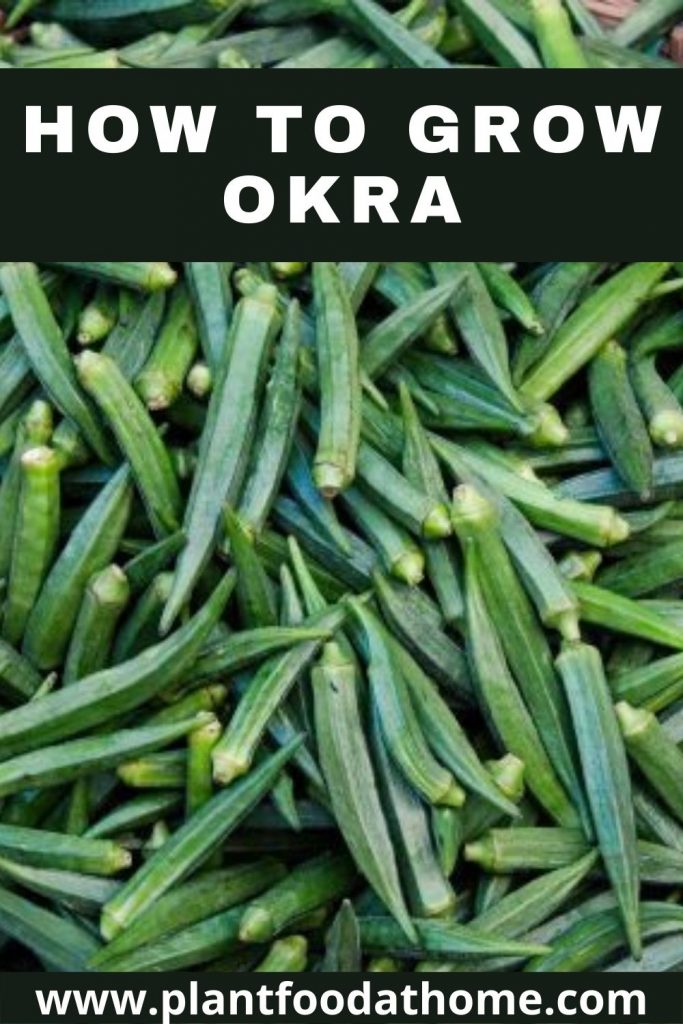Okra is a productive vegetable to grow in the vegetable garden, producing an abundant harvest of food for your table. Here we’ll explore how to grow okra including details on planting, caring for your okra plants, harvesting okra, and some ideas for how to eat them. Let’s dig in.
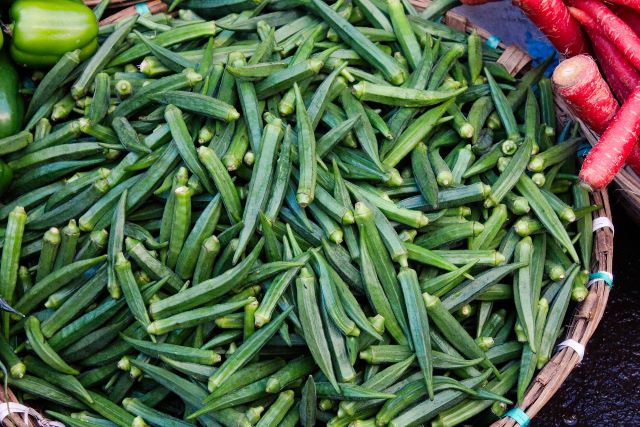
Table of Contents
Okra Plant Profile
Okra, whose botanical name is Abelmoschus esculentus, is also known as lady’s fingers, okro, or ochro, and is a flowering and edible plant that belongs to the mallow family. This is the same family that includes cotton, cacao, hibiscus, and durian.
It is mainly cultivated in subtropical, tropical, and warm temperate regions around the world.
Okra originated in West Africa, Ethiopia, and South Asia and is now used extensively in Southern dishes in the US as well as Indian cuisine.
The okra plant is a perennial plant but is often cultivated as an annual in regions with temperate climates. It grows up to 6.6 ft (2 meters) tall, with heart-shaped, lobed leaves that are around 4-8 inches (10-20 cm) in length and width. Most often okra has pale yellow flowers with a purple center that grow to around1.5-3 inches (4-8 cm) in diameter. Though some varieties produce white, red, or pink flowers.
The okra fruit or seed pod is the most often eaten part of the plant, though the young leaves are also edible. Okra is long and skinny and resembles a hairy capsule with a cross-section containing plenty of seeds. They grow up to 7 inches (18 cm) in length though they are best harvested at 2-4 inches (5-10 cm) long.
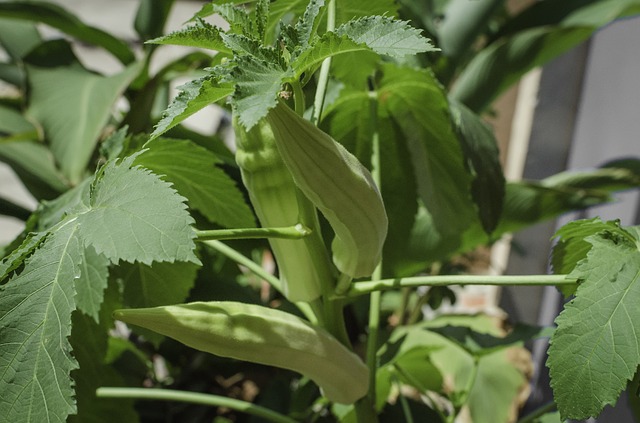
Ideal Growing Conditions for Okra
Climate for Growing Okra
Okra thrives in a very warm climate. It can tolerate the heat better than the cold. It’s best to plant okra when the air temperature is between 70-90°F (21-32°C). If you remember that okra originates from a hot climate, then those are the conditions to replicate for a thriving harvest.
Soil for Growing Okra
In the right hot climate, okra will grow even in very poor soil conditions. However, it will grow best if you can provide it with well-draining soil that is rich in organic matter.
Add a generous amount of organic compost and aged manure and mix it into the soil before planting.
The ideal soil pH is neutral between 6.5 to 7.
Water Requirements for Growing Okra
Like many food-producing plants, okra needs regular watering to really thrive. So during the hot summer months, daily watering may be required for optimum growth and an abundant harvest. During periods of rain, less watering is required as well as in cooler weather.
Focus watering at the base of the plant while being careful not to erode the soil. And avoid watering the foliage as it can become a breeding ground for fungi.
Sunlight for Okra
As a very warm climate plant, okra requires full sunlight of at least 8-10 hours a day. So choose a sunny spot in your garden to plant okra.
Fertilizer for Okra
Okra will grow just fine in nutrient-rich soil. However, if the soil available is not ideal, fertilizers will help them flourish and produce abundantly.
Ideally, a well-balanced organic fertilizer such as this one can be applied when seedlings reach 6 inches (15 cm) in height.
At around 6 weeks, a further dressing of compost and aged manure can be added around the okra plant and again halfway through the growing season.
How to Plant Okra
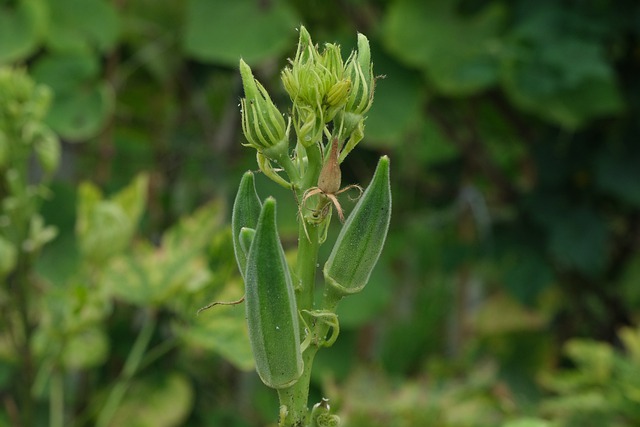
Growing Okra From Seed
- Start by soaking the okra seed in water over night. This process will help soften the hard outer coating of the seeds and speeds up germination.
- Prepare the soil in the planting bed with compost and aged manure.
- Plant 3-4 seeds in 1/4 inch (6 mm) deep hole, spacing them about 1 foot (40 cm) between plantings. Carefully cover the seeds with soil.
- Gently water the seed bed and make sure to keep the soil moist until the seeds germinate in 10 to 14 days. Later, depending on the seed germination rate, you can thin the seedlings to the strongest one and make sure the plants have at least 1 foot (40cm) between plants.
- Keep up regular watering while the seedlings are establishing and until they reach at least 6 inches (15 cm) in height.
Starting Okra Seeds Indoors
In cooler climates, you can get a head start on the growing season by starting okra seeds indoors in seed trays 2-3 weeks before your last expected frost.
To ensure the highest germination rate you can use a seedling heat mat like this one to make sure the soil is warm enough. Otherwise, place your seed tray near a warm sunny window for light and warmth.
Follow the steps above for growing okra from seed but do so in seed trays or pots.
Once the okra seeds have spouted, make sure the weather has warmed sufficiently before transplanting them outdoor. It’s best to wait at least 3 weeks after the last frost.
Seedlings should also be hardened off before transplanting them outdoors. You can read more on this process in our article: Hardening Off Seedlings (& Avoiding Transplant Shock).
Propagating Okra Through Cuttings
Although okra is mainly propagated through seeds, cuttings can also be used to propagate them.
- Cut a stem about 8 inches (20 cm) in length from a healthy okra mother plant.
- Remove the leaves at the bottom of the cutting and keep a few at the top.
- Some gardeners like to use a rooting hormone at this point. Or you can try without it. If you do prefer a rooting hormone, this usually comes in a powdered form like this rooting powder here.
- Plant the cutting in a moist organic potting mix like this one.
- Position in a bright spot away from direct sunlight while roots are establishing.
- Keep the soil moist but make sure it’s free-draining, and in a 4-6 weeks you will have new okra plants.
Okra Plant Care Tips
- Remove the weeds from the base of the okra plants as they grow. Applying mulch around them will help control the weeds and retain the soil moisture.
- Thinning the okra plants promotes growth and fruit production. So give them room to grow. At least 1 foot (40 cm) between plantings is ideal, if not more if space allows.
- Although okra plants do not require staking, you can provide them with one to help the particularly tall plants to have additional growing support.
Companion Plants for Okra
Companion planting helps repel pests and attract beneficial insects for pollination. By planting companion plants close together, you can boost the production and harvest of your crops.
The best companion plants for okra are the plants that could benefit from the shade of the tall okra plants such as lettuce and peas. Radish is also a great companion plant for okra as it helps loosen the soil that allows okra plants to develop stronger and sturdier roots as they grow deeper.
Stink bugs can attack and feed on tomatoes, beans, and peppers so planting okra near these plants can help repel them.
How Long Does it Take an Okra to Produce Fruit?
In ideal growing conditions, okra starts producing flowers around 50-65 days after planting and seed pods form soon after. Okra then continues to produce pods for 10-12 weeks or until the first frost.
Okra is a self-fertile plant, meaning the flower has both male and female parts and will fruit without the aid of pollinators. But although beneficial insects are not required to produce a healthy crop of okra, they can boost your harvest, so think about including flowering plants to attract pollinators to your garden.
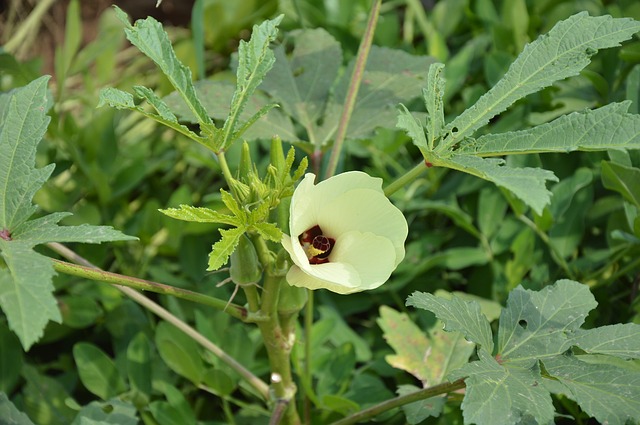
Harvesting Okra
Okra needs to be harvested when the pods are still soft. This can be done a few days after the blooms fade. Harvest the pods every day or two if you can or as often as you can as they can quickly turn tough and woody as they grow bigger. The ideal size to pick okra is 2-4 inches (5-10 cm) long.
Cut the stem above the cap of the pod using pruners or even scissors.
Those with sensitive skin may want to wear gloves when harvesting okra as the spines from the plant can irritate the skin.
How to Eat Okra
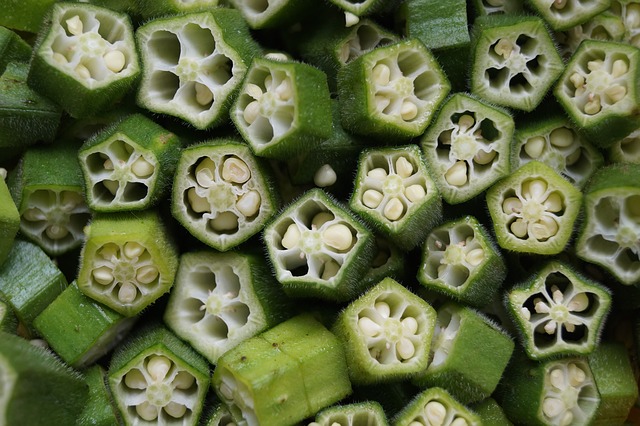
Okra can be polarizing for some people due to the ‘sliminess’ this vegetable produces. The gooey or sliminess is technically known as ‘micilage’ and is actually very good for your health if you can get over the texture.
One gardener said their first experience of eating okra was like swallowing a mouth full of saliva – eww! But don’t let this put you off. There are many different ways to eat okra and get rid of the slime factor.
You can eat okra raw (for the full slime experience), steamed, pickled, grilled, roasted, stewed, sauteed, or stir-fried to name a few.
If you’ve never eaten okra, you may be wondering what okra tastes like? Okra is mild with a slightly grassy flavor that is kind of sweet. Okra also tastes different depending on how you cook it and often takes on the flavor profile of whatever it is cooked with.
Before consuming okra, make sure to give it a good clean. Remove the cap by slicing it off. Then go ahead and slice okra according to your desired size and shape for your dish.
For more ideas for cooking with okra, please see the below recipe suggestions.
Okra Recipe Ideas
If you are looking for ways to cook okra, we’ve compiled a list of a few delicious recipes using okra here:
- Okra with Tomatoes
- Okra Recipe, Mediterranean-Style (Bamya)
- Sauteed Okra with Onions and Garlic
- Fried Okra
- Stewed Okra
- Creole Chicken Okra
- Roasted Okra
Storing Okra
Okra is best eaten and used when fresh. However, if your supply is abundant, okra can be stored in the refrigerator and can last well for a few days. For a longer storage life, don’t wash or cut them. Instead, place the okra in a plastic bag or container and pop them in the refrigerator.
You can also freeze okra where they’ll be good for a few months. Frozen okra is best used in cooked dishes like stews.
Canning or pickling okra is another way of preserving them.
Common Pests and Diseases of Okra
Okra is susceptible to a number of pests and diseases. They either damage the foliage, the pods, or the roots.
Aphids and whiteflies feed on the okra leaves by sucking out the sap. They can be managed using neem oil.
Corn earworms defoliate the okra plants. Spray mineral oil on the silks as soon as they form to manage and control these insects.
Stinkbugs feed on the pods by sucking the sap out of the pods. This causes deformation of the pods. Spraying insecticidal soap is effective in controlling them.
Okra is a warm-weather plant, so cooler weather and rain can promote disease. To name a few: Anthracnose, Rust, Powdery Mildew (treat with a DIY milk spray here), and Root Rot or Stem Rot, which are diseases caused by fungi that affect the leaves, the stem, and roots.
Severe cases of disease lead to plant wilt and possible failure. It’s best to manage them as you spot them using horticultural neem oil or fungicides with copper or sulfur.
Removing the damaged areas will prevent diseases from spreading to other plants. Also prune off any dead leaves to help promote airflow about the plant, especially around the lower base.
Conclusion
Given the right warm growing conditions, okra is an easy vegetable to grow and will produce an abundant harvest for you to eat. While okra does have a somewhat slimy texture, it is packed with vitamins, fiber, and antioxidants, so it’s really good for you. And there are endless ways you can cook and eat okra, making it a versatile and desirable vegetable to grow in your vegetable garden!
Further reading:
- Okra Dying? Common Causes and Solutions!
- How to Grow Chayote Squash (Choko) – the easy way!
- How Many Ears Of Corn Grow On One Stalk? (Answered!)
- Growing Tomatillo Plants and How to Eat Tomatillos
- Curry Leaf Plant: Growing, Caring and Eating Curry Leaves
